This post may contain affiliate links. See my disclosure policy.
This Salmon Chowder Recipe is made with fresh salmon and hearty potatoes in a rich, creamy, and flavorful broth. It’s versatile and easy to make, with countless optional additions and substitutions. Read on for more!
You may also like my Chicken Corn Chowder, this Creamy Corn and Zucchini Chowder, or classic New England Clam Chowder.
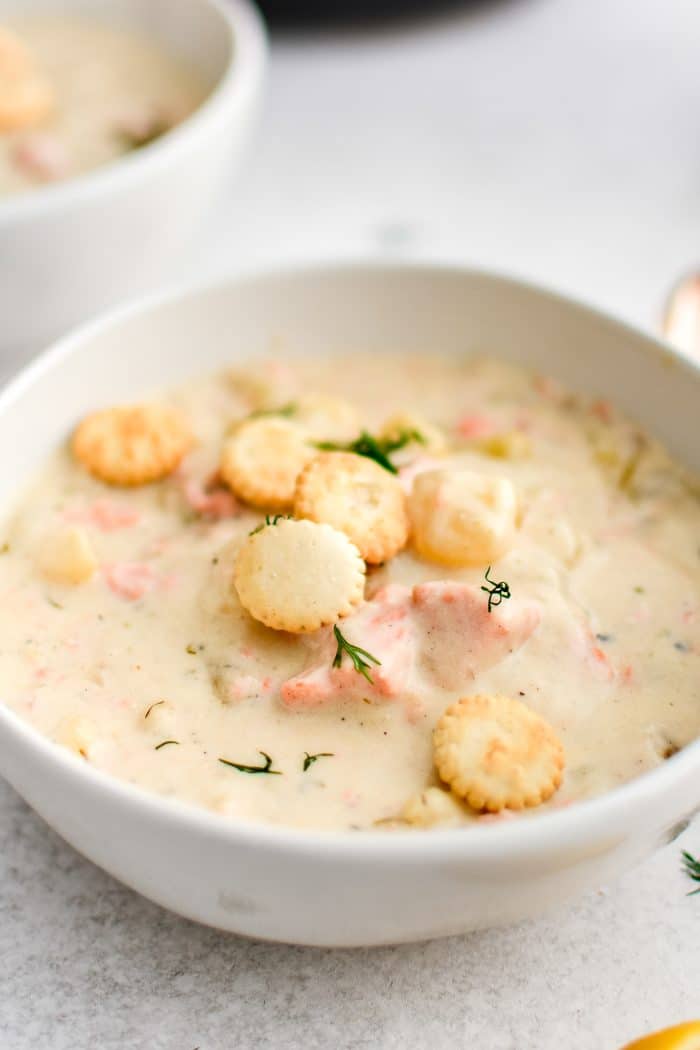
About This Recipe
This is my favorite one-pot, 100% uncomplicated salmon chowder recipe. It’s simple, delicious, and oh-so comforting. It’s my go-to when I’m craving something decadent, luxurious, and seafood-ey that doesn’t take all day to cook. Of course, it’s very versatile. There are so many ways to make this recipe your own – if that’s your thing, of course.
- Taste: Rich, savory, and creamy with the distinct flavor of salmon.
- Difficulty: So easy!
- Freezer-Friendly: No. I don’t recommend freezing this salmon chowder recipe, primarily due to texture changes after thawing and reheating.
- Top Tip: Add the salmon toward the end of cooking to avoid overcooking.
Table of Contents
Ingredients Substitutions
Below are notes, substitutions, and suggested additions for this salmon chowder recipe. You will find the printable recipe with measurements in the recipe card at the bottom of this page.

Butter: Butter is rich and flavorful! Feel free to substitute it with olive, coconut, or vegetable oil.
Onion and Celery: The onions and celery are slowly cooked in butter until softened, drawing out their natural sweetness. You may also want to add carrots.
Seasoning and Aromatics: This recipe uses fresh garlic, dried thyme, bay leaves, salt, and black pepper. You can swap the fresh garlic for approximately 1 teaspoon of dried garlic and substitute the dried thyme for about 1 tablespoon of fresh minced thyme.
Broth: I chose to make this recipe with chicken broth since it’s an ingredient many of us have stocked in our pantry. Vegetable broth or water are great substitutes; however, water will require more salt. For even more flavor, swap half of the broth or water for bottled clam juice. Clam juice is flavorful yet subtle, highlighting the already existing seafood flavor from the salmon.
Potatoes: Potatoes add heartiness and help thicken the broth. Yukon gold or red potatoes hold their shape after cooking, while Russet potatoes tend to fall apart. Use the variety that suits your preference.
Heavy cream: I like using heavy cream for chowders. Heavy cream is less likely to split or curdle if boiled and it tastes absolutely delicious. You can lighten it slightly by using half whole milk and half heavy cream or purchase half-and-half from the grocery store. To make this recipe dairy-free, substitute the cream or milk with coconut milk, almond milk, or another dairy-free alternative.
Thickener (optional): All-purpose flour is used to thicken the chowder, however it is entirely optional. If you prefer a thinner broth, omit the flour – it will still taste delicious. For a gluten-free version, you can use cornstarch or arrowroot powder mixed with a equal parts cold water to form a slurry and add it towards the end of cooking.
Salmon Fillets: This recipe calls for at least 1 pound of fresh salmon fillets cut into 1-inch cubes, but feel free to add up to two pounds of salmon if you’ve got it. Swap regular salmon for smoked salmon (whole smoked fillets, not the stuff we love to put on bagels) for smoky flavor.
Recipe Variations and Optional Additions
There are countless ways to “dress up” this simple salmon chowder. Here are some of my favorite variations and additions.
- Bacon: Bacon adds a ton of salty, smoky flavor. Fry it up and use the leftover grease instead of butter to sauté the vegetables.
- Corn: Fresh, frozen, or canned corn adds sweetness to cream-based chowders. It’s a must-have addition whenever I add bacon.
- Cajun Salmon Chowder: Seafood and Cajun seasoning are a match made in culinary heaven. I suggest adding 1-2 teaspoons of Cajun seasoning at the same time as the fresh garlic. Note: Cajun seasoning typically contains salt. Limit the amount of additional salt until the end of cooking.
- White Wine: Before adding the chicken broth, stir in about half a cup of dry white wine and allow it to reduce by half. Adding wine provides a bright, slightly tangy layer of flavor that can elevate the creamy, rich elements of the soup.
How to Make Salmon Chowder (Overview with Pictures)

1. Soften the vegetables. Melt the butter in a large pot set over medium heat. Cook the celery and carrots until soft.

2. Add the seasoning and aromatics. Add the minced garlic, thyme, salt, and pepper. Stir continuously for 30 seconds or until fragrant.

3. Sprinkle the flour over the vegetables (optional). Flour helps thicken the soup. Omit for a thinner broth.

4. Make the roux. Stir and cook the flour with the vegetables until the raw flour taste is gone and it begins to take on color.

5. Add the broth. Mix well and increase the heat to high. Bring to a boil, then reduce the heat to low.

6. Add the potatoes. Stir in the potatoes and add the bay leaf. Simmer, stirring occasionally for 15 minutes, or until the potatoes are tender.

7. Add the heavy cream. Stir continuously until simmering. Do not boil vigoriously.

8. Stir in the salmon and dill. Simmer gently for 8-10 minutes or until the salmon flakes apart with a fork.
Top Tips
- Avoid boiling after the cream is added. Once the cream or milk has been added, bring your chowder just to a simmer, but avoid boiling. Boiling can cause the dairy to curdle, which affects the texture and appearance.
- Use a combination of liquids. If possible, combine vegetable/chicken broth with clam/seafood stock. Fish or clam stock adds depth which complements the richness of the cream.
- Add the salmon towards the end of cooking to avoid overcooking it. The heat of the chowder will gently cook the salmon through, keeping it tender and moist.
- Garnish with fresh herbs like chopped parsley or chives and serve with lemon wedges to help cut through the creaminess of the broth. Hot sauce, like vinegary Tabasco sauce, is also delicious.
Frequently Asked Questions
Yes. Canned salmon can be used to make salmon chowder. For the best results, shop for canned salmon packed in water without the skin and bones. Wild-caught salmon gives the best flavor and texture. Add the salmon at the very end of cooking, gently stirring it into the simmering broth.
Stored in an airtight container, salmon chowder can last up to 4 days in the refrigerator. Reheat it gently on the stovetop to prevent the cream from separating.
I do not recommend freezing salmon chowder because heavy cream and potatoes tend to separate or become grainy after thawing
Looking for more easy salmon recipes? Check out my creamy one-pan Marry Me Salmon, fresh and delicious Baked Salmon with Lemon Butter, and this sweet and savory Honey Garlic Salmon recipe.
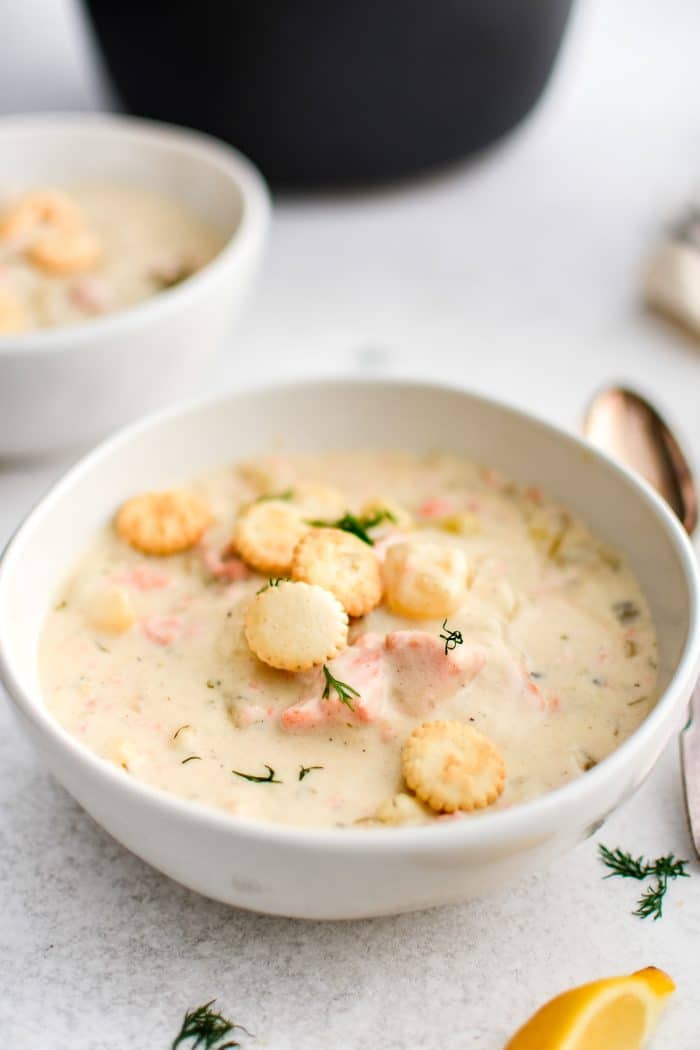
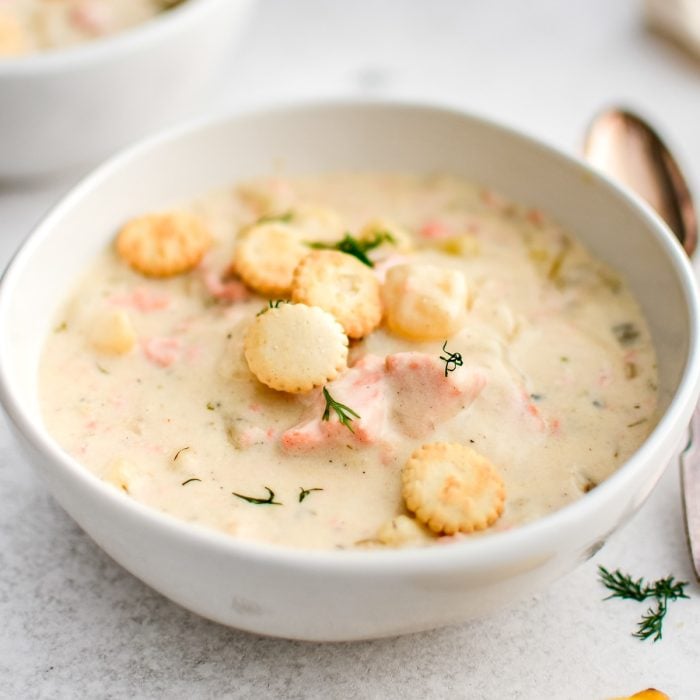
Creamy Salmon Chowder Recipe
Ingredients
- 2 tablespoon butter, or olive oil
- 2 ribs celery, chopped
- 1 large white onion, diced
- 3-5 cloves garlic, minced
- ½ teaspoon dried thyme
- 1 teaspoon salt, plus more to taste
- ½ teaspoon black pepper, plus more to taste
- ¼ cup all-purpose flour, see notes for substitution
- 4 cups low-sodium chicken broth, see notes for substitution
- 1 pound Yukon gold potatoes, chopped into 1/2-inch cubes, see notes
- 1 bay leaf
- 3 cups heavy cream, see notes
- 1-2 pounds boneless skinless salmon fillets, cut into 1-inch pieces
- 1 tablespoon fresh dill or parsley, minced, optional
Instructions
- Soften the vegetables. Melt the butter in a large pot set over medium heat. Add the celery and carrots and cook until soft, about 5-8 minutes.
- Add the seasoning and aromatics. Add the minced garlic, thyme, salt, and pepper. Cook for 30 seconds or until fragrant, stirring continuously.
- Add the flour to the vegetables (optional). The flour helps thicken the broth. Omit for a thinner broth, or see suggested gluten-free suggestions in the notes section below. Stir and cook the flour with the vegetables until the raw flour taste is gone and it begins to take on color.
- Add the broth. Increase the heat to high and stir in the broth. Bring to a boil, then add the potatoes. Reduce the heat to low and simmer for 15 minutes, or until the potatoes are tender.
- Add the heavy cream. Stir continuously until it reaches a simmer. Do not boil.
- Stir in the salmon and dill and simmer gently for 8-10 minutes or until the salmon flakes apart with a fork.
- Season with additional salt and black pepper to taste and garnish with fresh lemon juice, fresh minced parsley or dill, and hot sauce, if desired.
Notes
- Butter: Substitute with olive oil or coconut oil.
- Fresh garlic: Swap for 1 teaspoon of dried garlic plus more to taste.
- Dried thyme: Swap for 1 tablespoon of fresh minced thyme plus more to taste.
- Broth: Substitute the chicken broth for water or vegetable broth. For even more flavor, swap half of the broth or water for bottled clam juice.
- Potatoes: Yukon gold and red potatoes hold their shape after cooking, while Russet potatoes tend to fall apart. Use the variety that suits your preference. For a low-carb alternative, try adding cauliflower.
- Heavy cream: You can use a 1:1 ratio of milk and heavy cream or purchase half-and-half from the grocery store. Low-fat milk exclusively is not recommended. To make this recipe dairy-free, substitute the cream or milk with coconut milk, almond milk, or another dairy-free alternative.
- Flour: Omit for a thinner broth. For a gluten-free version, you can use cornstarch or arrowroot powder mixed with a little cold water to form a slurry and add it towards the end of cooking.
- Salmon: Fresh or frozen (thawed) boneless skinless salmon fillets are best. Canned salmon can be used when fresh salmon isn’t available. Use canned salmon packed in water without the skin and bones.
Optional Additions and Recipe Variations:
- Bacon: Use the leftover grease instead of butter to sauté the vegetables.
- Corn: Fresh, frozen, or canned, corn adds sweet flavor to cream-based chowders. Highly recommended if you’re adding bacon.
- Cajun Seasoning: Add 1-2 teaspoons of Cajun seasoning at the same time as the fresh garlic. Note: Cajun seasoning typically contains salt. Limit the amount of additional salt until the end of cooking.
- White Wine: Before adding the chicken broth, stir in about half a cup of dry white wine and allow it to reduce by half.
Top Tips:
- Avoid boiling after the cream has been added. Once the cream or milk has been added, bring your chowder just up to a simmer, but avoid boiling. Boiling can cause the dairy to curdle, which affects the texture and appearance.
- Use a combination of liquids. If possible, use a combination of vegetable/chicken broth with clam/seafood stock.
- Add the salmon towards the end of cooking to avoid overcooking it. The heat of the chowder will gently cook the salmon through, keeping it tender and moist.
Serving: Serve immediately with chopped parsley or chives. For freshness, serve with lemon wedges to help cut through the creamy broth. Vinegary hot sauce, like Tabasco sauce, is also recommended. Storage and Leftovers: Store leftovers in an airtight container in the refrigerator for up to 4 days. Freezing is not recommended. Reheat gently on the stovetop, adding additional water or broth as needed, as the soup will thicken upon refrigeration.
Nutrition
Nutrition information is automatically calculated, so should only be used as an approximation.



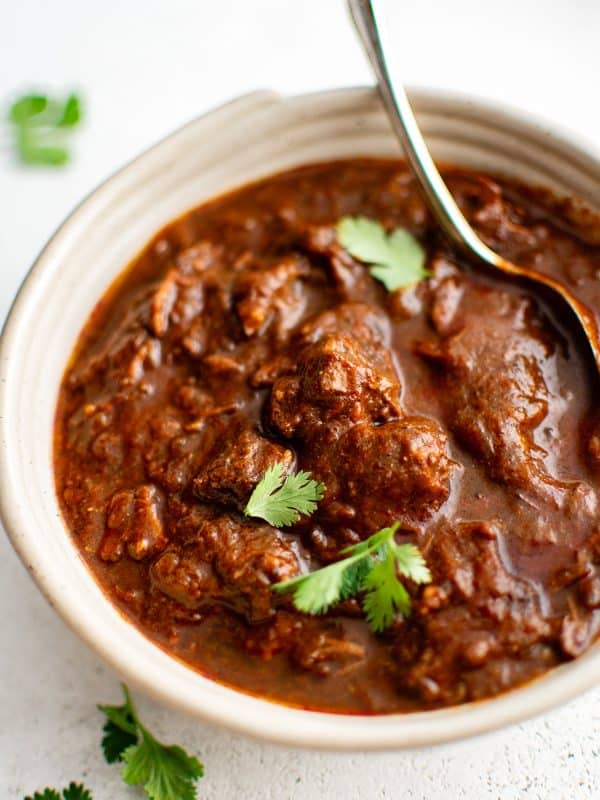
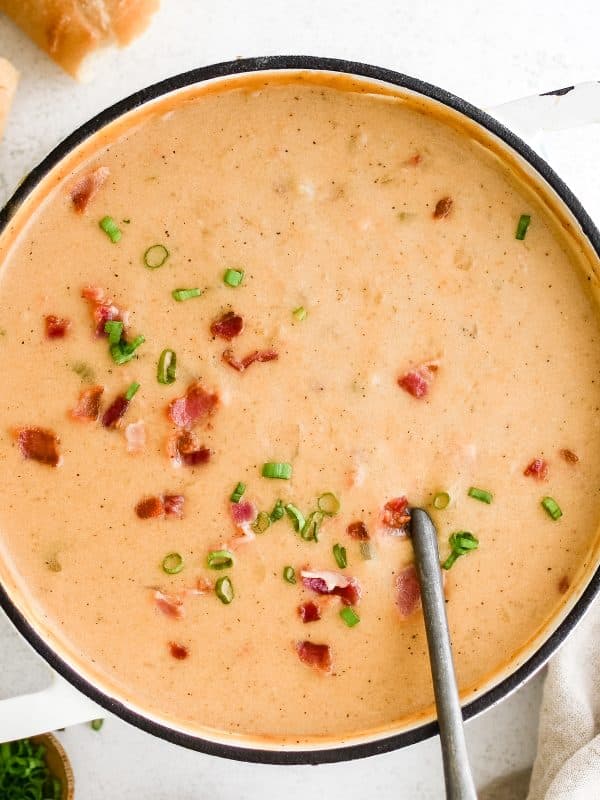










I’m so glad to hear you loved the salmon chowder and experimented with adding corn and bacon—that sounds absolutely delicious! You’re right about the directions; it should indeed say to sauté celery and onions, not carrots. Thanks for catching that mistake, and I’ll make sure to correct it in the recipe. Using 2 pounds of salmon to balance the potatoes is a great tip as well. Thank you for trying out the recipe and for your thoughtful feedback!
Loved it. Ate as recipe calls. Next night added corn and bacon. Both delicious. Used 2 pounds salmon which balanced the potatoes. I believe in the directions you meant sauté celery and onions, not carrots. No carrots in ingredients. Delicious! Thank you.